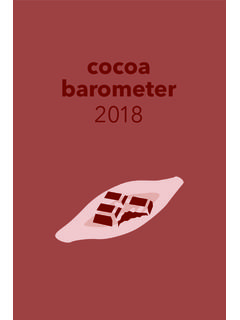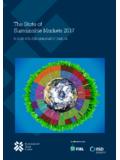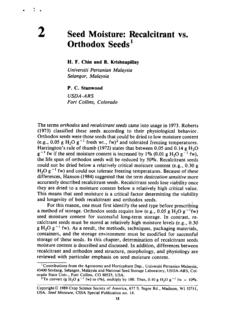Transcription of THE MARKET FOR ORGANIC AND FAIR-TRADE …
1 THE MARKET FOR ORGANIC AND FAIR-TRADE cocoa . Study prepared in the framework of FAO project GCP/RAF/404/GER. Increasing incomes and food security of small farmers in West and Central Africa through exports of ORGANIC and FAIR-TRADE tropical products . September 2009. The designations employed and the presentation of material in this information product do not imply the expression of any opinion whatsoever on the part of the Food and Agriculture Organization of the United Nations (FAO) concerning the legal or development status of any country, territory, city or area or of its authorities, or concerning the delimitation of its frontiers or boundaries. The mention of specific companies or products of manufacturers, whether or not these have been patented, does not imply that these have been endorsed or recommended by FAO in preference to others of a similar nature that are not mentioned. The views expressed in this information product are those of the author(s) and do not necessarily reflect the views of FAO.
2 All rights reserved. Reproduction and dissemination of material in this information product for educational or other non-commercial purposes are authorized without any prior written permission from the copyright holders provided the source is fully acknowledged. Reproduction of material in this information product for resale or other commercial purposes is prohibited without written permission of the copyright holders. Applications for such permission should be addressed to Chief, Electronic Publishing Policy and Support Branch, Communication Division FAO, Viale delle Terme di Caracalla, 00153 Rome, Italy, or by e-mail to THE MARKET FOR ORGANIC AND FAIR-TRADE cocoa . Study prepared in the framework of FAO project GCP/RAF/404/GER. Increasing incomes and food security of small farmers in West and Central Africa through exports of ORGANIC and FAIR-TRADE tropical products . By Ellen Pay Trade and Markets Division FOOD AND AGRICULTURE ORGANIZATION OF THE UNITED NATIONS.
3 Rome, 2009. 1. 1. THE WORLD MARKET FOR cocoa .. 3. OVERVIEW .. 3. PRICES .. 4. GRINDINGS AND CONSUMPTION .. 4. 2. THE MARKET FOR ORGANIC AND FAIR-TRADE cocoa 6. CONSUMPTION PATTERNS .. 6. THE MARKET FOR ORGANIC cocoa .. 6. Overview .. 6. The European MARKET for ORGANIC cocoa and cocoa 7. The MARKET for ORGANIC cocoa and cocoa products in the United 8. THE MARKET FOR FAIR-TRADE CHOCOLATE .. 8. Overview .. 8. The European MARKET for FAIR-TRADE cocoa 9. The MARKET for FAIR-TRADE cocoa products in the United 10. OUTLOOK .. 11. 2. 1. THE WORLD MARKET FOR cocoa . OVERVIEW. According to FAO, worldwide imports of cocoa beans, processed cocoa products and products containing cocoa reached million tonnes in 2007, up by an average 6 percent annually over the course of the past decade. Figure 1. Worldwide imports of cocoa beans, processed cocoa products and products containing cocoa , 1997 2007 (in tonnes). 10000000 cocoa powder 9000000 cocoa paste 8000000 cocoa butter 7000000 cocoa beans 6000000 Products containing cocoa 5000000.
4 4000000. 3000000. 2000000. 1000000. 0. 1997 1998 1999 2000 2001 2002 2003 2004 2005 2006 2007. In value terms, worldwide imports of cocoa beans, processed cocoa products and products containing cocoa fell to a low in the late 1990s, reflecting the overall global trend in prices for agricultural commodities. Since then, the value of worldwide imports has increased continuously, from US$ billion in 2000 to US$ billion in 2007, representing an average annual growth rate of nearly 14 percent. Products containing cocoa account for nearly two fifths of worldwide cocoa imports in value terms, followed by cocoa beans (22 percent), cocoa butter (12 percent), cocoa paste (5 percent), and cocoa powder (4 percent). According to Eurostat data, imports of cocoa beans, processed cocoa products ( cocoa paste, butter and powder) and chocolate into the European Union stood at million tonnes in 2008, up by an average 4 percent annually over the period 1999 2008.
5 In value terms, imports totalled billion euro, up by an average 6 percent over the period. Meanwhile, imports of cocoa beans, processed cocoa products ( cocoa paste, butter and powder) and chocolate into the United States stood at million tonnes in 2008, up by an average 3 percent annually since 1999. In value terms, imports reached US$ billion in 2008, representing an average annual growth rate of 9 percent over the period 1999 2008 (USDA-FAS). The United States has traditionally relied upon European imports to supply its MARKET for processed cocoa products. In 2007, however, NAFTA members Mexico and Canada accounted for two thirds of total imports of cocoa products into the United States, reflecting the chocolate industry trend of American plants relocating 1. to Canada or Mexico, where manufacturing costs are lower . 1. ERS-USDA (2009). 3. PRICES. Figure 2 represents the evolution of the average monthly ICCO prices recorded over the period September 1984 July 2009.
6 As was the case for agricultural commodities in general, prices for cocoa fell sharply during 1999 2000, reflecting a situation of abundant supplies and weaker than anticipated demand. By the end of the century, inflation-adjusted prices for cocoa were at their lowest level ever recorded, with the 1999 2000. 2. average price representing only one third of the price recorded in 1971 1972 . A three-year period of constant increases followed, and in February 2003 the average cocoa price stood at US$2 239 per tonne, its highest level in nearly two decades. Prices recorded another sizeable decrease during the 2003/04 season to reach a two-year low of US$1 405 in June 2004, and hovered between approximately US$1 500 1 750. per tonne until the end of 2006, in line with the trend of the past two decades. In January 2007, world cocoa prices began climbing rapidly, reflecting an overall upturn in agricultural commodity prices. By mid-2008, commodity prices had escalated to their highest levels in 30 years, provoking widespread concern over an apparent world food crisis.
7 cocoa prices reached a record high of US$3 022 per tonne by June 2008. In the second half of 2008, prices fell as dramatically as they increased in the first half. However, prices started climbing sharply again by the end of the year, indicating that the period of high prices may 3. persist in the medium term . Figure 2. ICCO monthly average cocoa prices, September 1984 July 2009 (in US$ per tonne). 3500. 3000. 2500. 2000. 1500. 1000. 500. 0. Sep- Sep- Sep- Sep- Sep- Sep- Sep- Sep- Sep- Sep- Sep- Sep- Sep- 84 86 88 90 92 94 96 98 00 02 04 06 08. Source: Index Mundi, GRINDINGS AND CONSUMPTION. Europe dominates world grindings of cocoa beans. More than 41 percent of worldwide grinding takes place in Europe, amounting to a volume of million tonnes in 2008/09. Total cocoa grindings in Europe increased by an average 7 percent annually over the period 2001/02 2005/06, but fell by nearly 1 percent 4. annually from 2006/07 to 2008/09.
8 The Netherlands is Europe's and the world's largest grinder of cocoa beans, grinding 475 000 tonnes of beans in 2008/09, or 13 percent of worldwide grindings. Germany comes second, with grindings totalling 360 000 tonnes in 2008/09. The Netherlands and Germany combined account for 55 percent of total grinding 2. International cocoa Organization (ICCO) (2007). 3. See FAO (2009). 4. World cocoa Foundation (2009). 4. in Europe. Other important European grinders are France and the United Kingdom, while Italy, Spain and 5. Belgium play an important role as well . The United States is the world's second largest grinder of cocoa beans after the Netherlands, grinding 6. 400 000 tonnes of cocoa beans in 2008-2009, or 11 percent of the worldwide total . Consumption levels of chocolate confectionary by far the largest end-use of cocoa in Europe are amongst the highest in the world, and consumption levels tend to be highest in northern European countries.
9 Figure 3 shows that the annual per capita intake in Ireland, Switzerland, the United Kingdom, Belgium, Norway, Germany and Sweden exceeds 8 kg, well above the average per capita consumption of kg in the United States. According to CBI (2007), Western European consumption levels of confectionary and drinks containing cocoa and chocolate will continue to increase. In addition, consumption levels in Central and Eastern Europe countries, which are currently far below those in Western Europe, can be expected to 7. catch up with Western European levels over time . The per capita consumption of cocoa in the United States has increased incessantly since the mid-1950s, when the average per capita intake stood at pounds (in cocoa bean equivalent), until 2005, when consumption levels reached an all-time high of pounds. Since then, the per capita consumption has 8. decreased slightly to 6 pounds in 2007 . Figure 3. Annual per capita consumption levels of chocolate confectionary in selected countries, 2007 (in kg).
10 UK. Belgium Norway Germany Sweden Denmark Finland Austria US. France Slovakia Hungary Netherlands Greece Spain Italy Portugal Slovenia Poland 0 2 4 6 8 10 12. Source: CAOBISCO. 5. CBI (2007). 6. World cocoa Foundation (2009). 7. CBI (2007). 8. Food Availability Data System, Economic Research Service, United States Department of Agriculture. 5. 2. THE MARKET FOR ORGANIC AND FAIR-TRADE cocoa PRODUCTS. CONSUMPTION PATTERNS. According to industry sources, the world MARKET for premium chocolate (including flavoured, single-origin, ORGANIC , ethically traded and high- cocoa chocolate) has grown significantly in recent years, and will continue to do so, even in times of economic recession, as consumers seek out affordable luxuries during bad times, 9. having foregone larger indulgences . It is predicted that the global premium chocolate MARKET will grow from 10. US$7 billion in 2007 to US$ billion (or US$ billion in the United States alone) in 2011 , driven by increasing consumer awareness of premium chocolate and a growing interest from the world's leading chocolate manufacturers in the premium chocolate segment.















